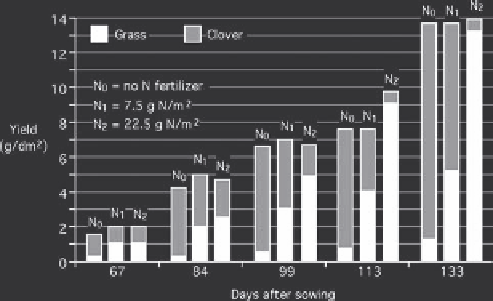Agriculture Reference
In-Depth Information
N
2
N
0
N
1
14
INTERFERENCE
Grass
Clover
12
N
2
Addition impact
Removal impact
10
N
0
= no N fertilizer
N
1
= 7.5 g N /m
2
N
2
= 22.5 g N /m
2
N
0
N
1
•
Competition
•
Parasitism
•
Herbivory
8
•
Allelopathy
•
Food source for
beneficials
N
1
Yield
(g / dm
2
)
N
0
N
2
6
N
1
N
2
N
0
4
N
1
N
2
Combined removal and addition
N
0
2
0
•
Mutualisms
•
Microhabitat midification
67
84
99
113
133
Days after sowing
FIGURE 15.2
Relative dominance of grass (Lolium rigidum)
and clover (Trifolium subterraneum) in relation to levels of nitro-
gen fertilizer.
(Stern, W. R. and C. M. Donald. 1961.
Australian
Journal of Agricultural Research
13: 599-614. With permission.)
FIGURE 15.1
Modes of interference underlying species
interactions in communities.
combined addition/removal interference between popula-
tions may modify the microclimate of a cropping system
in ways that affect populations of other species. Shading,
soil insulation, temperature and wind modification, and
altered moisture relations can combine to create a micro-
climate within the cropping system that is conducive to
the presence of organisms that are beneficial for the entire
crop community.
chemicals added to the soil by the grass) is at work in the
crop mixture.
These data raise other questions. For example, what
would happen in a crop mixture where the two species
involved had very similar nitrogen needs and procurement
abilities? Under conditions of limited nitrogen supply,
competition would probably result, and both species might
suffer, but eventually one would begin to dominate the
other. But another outcome is possible. The two different
species could have complementary ways of using nitrogen
when it is in limited supply; their timing of growth might
be different, or their root systems might occupy different
regions in the soil. They could thus avoid competition and
coexist in the same system.
COMPLEXITY OF INTERACTIONS
The ways in which the various populations of a crop
community influence the community as a whole through
their interferences may be complex and difficult to dis-
cern. An example will help illustrate this point.
Canopy development over time was studied in a grass
and clover mixture. The data from this study are shown
in Figure 15.2. When the interaction between grass and
clover is considered without any nitrogen being added, it
appears that competition for limited light under the canopy
of the crop mixture takes place. Shading by the clover
appears to inhibit the grass. We could conclude from these
data that due to its mutualism with nitrogen-fixing bacte-
ria, the clover is able to avoid nitrogen competition and
establish dominance. But the data obtained from adding
different amounts of nitrogen fertilizer to the mixture alter
the picture of community dynamics. The effect of adding
nitrogen is to shift the balance of species dominance; by
the last sample date the mixture at low nitrogen levels is
dominated by clover, but the mixture at high nitrogen
levels is dominated by grass. The advantage of one crop
over the other is altered by the availability of nitrogen,
with grass becoming more dominant as nitrogen supply
is increased. These data lead to somewhat different
conclusions; perhaps competition for light is the key
factor, or perhaps some complex interaction of light, nitro-
gen availability, and some other factor (e.g., allelopathic
C
OEXISTENCE
In complex natural communities, populations of ecologi-
cally similar organisms often share the same habitat without
significant apparent competitive interference, even though
their niches overlap to a considerable degree. Similarly, it
is often the case in natural communities that more than
one species shares the role of dominant species. It would
appear, then, that the principle of competitive exclusion,
which implies that two species with similar needs cannot
occupy the same niche or place in the environment, does
not fully apply in many communities.
The ability to “avoid” competition and instead coexist
in mixed communities leads to advantages for all involved
members of the community. Therefore, this ability may
well provide significant selective advantage in an evolu-
tionary sense. Although selection for competitive ability
has undoubtedly been very important in evolution, ecolo-
gists who study evolutionary biology now more widely
accept the idea that selection for coexistence may be more
the rule than the exception, especially in more mature
communities (Pianka, 2000).
















Search WWH ::

Custom Search